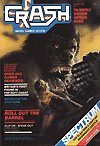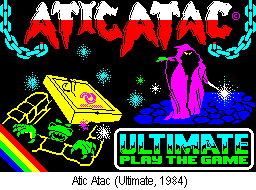|

By Lloyd Mangram
March
1984
Issue 2
 |
Coming
from a film-making background, Oliver Frey loves powerful
images and classic Thirties and Forties monochrome movies,
interests never better reflected than in the second
CRASH cover. It celebrated the proliferation of Donkey
Kong clones on the Spectrum at the time, and related
it to the Run It Again article in the issue comparing
Mario's many attempts to rescue his girl from the overgrown
ape's clutches. Note Kong's cavalier treatment of the
Spectrum itself - Oliver is to use the computer repeatedly
in cover illustrations as a player in the drama, quite
revolutionary in 1984.
|
It was a bit of a conceit to state on the cover 'Over 400
Games Reviewed' (345 were in the Guide), but the gung-ho exclamation
ideally indicates the small CRASH team's euphoria at public
reaction to Issue One - we wanted everyone to know that we
were the biggest and the best!
Attitudes within the trade were equally invigorating; several
specialist shops acclaimed CRASH as the long-awaited Spectrum
Bible. Even Computer & Video Games sent us a congratulations
card, but I fear they saw us as no competition, merely a local
fanzine to be encouraged; few people at the time realised
that as many as 50,000 copies of Issue One sold nationally.
It was a heady figure and one not to be repeated for quite
some time.
February's weather, however, brought CRASH down to earth.
The schedule ran late. Oliver worked for 30 hours nonstop
to complete Terminal Man, while John Edwards, newly-recruited
advertisement manager, stood anxiously by, waiting to take
the layout boards down to the London printer who wanted to
start at 9.30am. John had to catch the 6am train from Birmingham
New Street. At 4am on a freezing winter morning Oliver finished,
but Roger Kean (who was still working on the Living Guide)
did not.
At 5am, the boards still four pages incomplete, Roger drove
John the 40 miles to Birmingham through a heavy snow storm.
After ten minutes they were stuck on a steep hill outside
Ludlow. Turning back to try another route, they came across
a skidded lorry with its nose in a ditch. The unfortunate
driver turned out to be a local news trade wholesaler, delivering
magazines to Ludlow. Seeing the CRASH boards, as they gave
him a lift back into town, the driver exclaimed excitedly.
He owned a Spectrum and had loved the first issue. So there
they were, John frustrated, Roger struggling with the terrible
conditions, and a mad lorry driver who wanted nothing more
than to talk about high scores on Lunar Jetman!
 They
got through in the end, the printer did the job in time, and
Issue Two did arrive. To many people's horror, there were
five Games Of The Month ('confusing to have so many,' wrote
one reader), and in their very different ways they indicated
that Spectrum games were improving rapidly and almost beyond
belief. Top was Ultimate's classic Atic Atac, but Android
2 showed Costa Panayi flexing his muscles for Vortex with
the best 3-D effects yet seen. Like the first two, Krakatoa
(Abbex) offered large graphics which were a novelty in early
84, combined with complex gameplay and a wicked sense of humour
(also a rare commodity). Scuba Dive (Durell) also boasted
large and effectively fishy graphics with interestingly different
game objectives, while Microsphere's Wheelie was to
prove one of the most addictive games of the year. They
got through in the end, the printer did the job in time, and
Issue Two did arrive. To many people's horror, there were
five Games Of The Month ('confusing to have so many,' wrote
one reader), and in their very different ways they indicated
that Spectrum games were improving rapidly and almost beyond
belief. Top was Ultimate's classic Atic Atac, but Android
2 showed Costa Panayi flexing his muscles for Vortex with
the best 3-D effects yet seen. Like the first two, Krakatoa
(Abbex) offered large graphics which were a novelty in early
84, combined with complex gameplay and a wicked sense of humour
(also a rare commodity). Scuba Dive (Durell) also boasted
large and effectively fishy graphics with interestingly different
game objectives, while Microsphere's Wheelie was to
prove one of the most addictive games of the year.
We also ran our first 'real' competition, for Fantasy, promoting
Doomsday Castle. It was so successful that it set the
pattern for an increasing number of competitions thereafter.
Because of their oddly unergonomic arrangement, games only
offering the cursors for control lost percentage points badly
in those days! But we praised small-company inventiveness
in an article examining some joysticks which were actually
attached to the Spectrum to physically manipulate the cursed
cursors. Franco had a good listen to Currah's ahead-of-its-time
speech unit, and Hewson's Steve Turner was interviewed as
well as the four lads from Starzone.
I also had quite a few letters to print and answer - among
them was a complaint that at five pounds, the price of software
was far too high. Things never change . . .
|